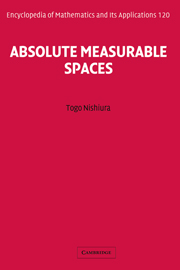Book contents
- Frontmatter
- Contents
- Preface
- Acknowledgements
- 1 The absolute property
- 2 The universally measurable property
- 3 The homeomorphism group of X
- 4 Real-valued functions
- 5 Hausdorff measure and dimension
- 6 Martin axiom
- Appendix A Preliminary material
- Appendix B Probability theoretic approach
- Appendix C Cantor spaces
- Appendix D Dimensions and measures
- Bibliography
- Notation index
- Author index
- Subject index
4 - Real-valued functions
Published online by Cambridge University Press: 14 May 2010
- Frontmatter
- Contents
- Preface
- Acknowledgements
- 1 The absolute property
- 2 The universally measurable property
- 3 The homeomorphism group of X
- 4 Real-valued functions
- 5 Hausdorff measure and dimension
- 6 Martin axiom
- Appendix A Preliminary material
- Appendix B Probability theoretic approach
- Appendix C Cantor spaces
- Appendix D Dimensions and measures
- Bibliography
- Notation index
- Author index
- Subject index
Summary
In this chapter, attention is turned to topics in analysis such as measurability, derivatives and integrals of real–valued functions. Several connections between real–valued functions of a real variable and universally measurable sets in R have appeared in the literature. Four connections and their generalizations will be presented. The material developed in the earlier chapters are used in the generalizations. The fifth topic concerns the images of Lusin spaces under Borel measurable real valued functions – the classical result that these images are absolute null spaces will be proved. A brief description of the first four connections is given next before proceeding.
The first connection is a problem posed by A. J. Goldman [64] about σ–algebras associated with Lebesgue measurable functions; Darst's solution [35] will be given. A natural extension of Darst's theorem will follow from results of earlier chapters. Indeed, it will be shown that the domain of the function can be chosen to be any absolute measurable space that is not an absolute null space.
The second addresses the question of whether conditions such as bounded variation or infinitely differentiability have connections to theorems such as Purves's theorem; namely, for such functions, are the images of universally measurable sets in ℝ necessarily universally measurable sets in ℝ? Darst's negative resolutions of these questions will be presented.
- Type
- Chapter
- Information
- Absolute Measurable Spaces , pp. 99 - 135Publisher: Cambridge University PressPrint publication year: 2008

